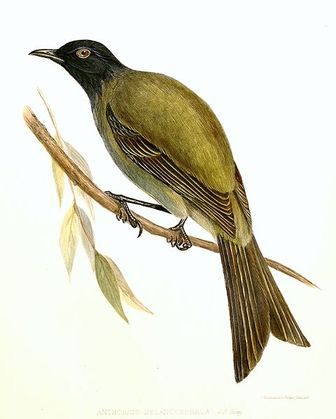Anthornis melanocephala
In appearance it was very similar to the New Zealand Bellbird Anthornis melanura but was considerably larger. Also the whole of the head and neck was brightly glossed in purplish or steel-blue.

The Anthornis melanocephala is classified as Extinct (EX), there is no reasonable doubt that the last individual has died.
Summary Anthornis melanocephala was endemic to Chatham, Mangere and Little Mangere Islands, New Zealand2. The last records were in 1906 from Little Mangere1. Ecology: It inhabited the islands' dense forest. Threats The reasons for its decline are obscure, but were probably a combination of habitat destruction, predation by introduced rats and cats2, and over-collection for the Museum trade3. References 1. Fleming (1939). 2. Greenway (1967). 3. Oliver (1955). More
* Other Species: Anthornis melanocephala was formely considered as the subspecies Anthornis melanura melanocephala * ITIS link: Anthornis G. R. Gray, 1840 * IUCN link: Anthornis threatened species Subcategories - This category has the following 2 subcategories, out of 2 total. More
Anthornis melanocephala, which attacks it most savagely when they meet.” Fleming says, “the black robin represents an early colonisation of the Chathams by a relation of the robins which developed even longer tarsi, a strongly rounded (degenerate) wing with a very long first primary, and a fixed melanic plumage — just as the Snares tomtit did, independently, but presumably at a later date. These features are a result of reduced selection pressure on islands lacking predators. More
Family : Meliphagidae
Genus : Anthornis
Species : melanocephala
Authority : Dickinson, 2003

